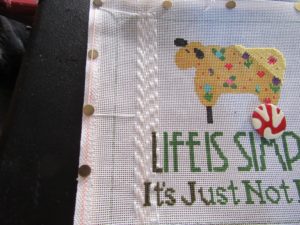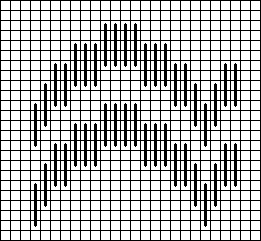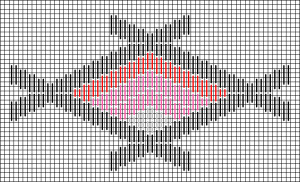
Last week as I was looking at darning patterns, I had a revelation — many stitches we use if stitched in a different order can be darning patterns. This may not be startling to you. But I’ve been using darning patterns since the mid-80’s. I love them. I’ve studied them. I’ve thought about them.
When you make a darning pattern your thread is going over and under threads, making Running Stitch, the stitch we use in hand sewing. To stitch a row, your needle will move in one direction only until you get to the end of the row. Unless your pattern requires two passes, the only difference in direction will be which end you start from. If your first row in vertical, every row will be vertical.
This gives pattern darning it’s distinctive look — you see the threads passing on the back of the canvas. That happens because of stitching each row in one direction.
It also means that with each row you stitch you are stitching something in every row of the area.
Contrast this with making a line of needlepoint, such as the line of Upright Gobelin, below. Instead of stitching in the same direction, you start every stitch from the same side. If the first stitch went from top to bottom, every stitch will go from top to bottom. This means your thread wraps around the canvas and that thread passes from row to row only at the ends.

What Does this Mean for Me?
Once you realize this, a whole world of possibilities for darning patterns opens up. As long as the rows go in a single direction and there is at least one thread between rows — it can be a darning pattern! Let’s look at two Bargellos to see what I mean. The top pattern, a simple scallop, is the one I’m using for the background of the piece pictured here. The bottom pattern, a diamond, cannot be done as a darning pattern because there are places where the stitches touch.


So why do we care? Because pattern darning does not wrap around threads, it is lower than regular needlepoint. Because you must leave open threads in this technique, it is also more open than regular needlepoint. Both these things make it outstanding for backgrounds. Where a complete Bargello background would look heavy, the same line in darning, with the open space, lower profile and alternation of light and dark, creates a background with a similar feel, but one that knows its place.
25 Darning Patterns Open through Wednesday
I’ so excited by this discovery and the great patterns you’ll discover in this class. I have reopened 25 Darning Patterns just through Wednesday at midnight, Pacific. Use the button below to sign up. If you would prefer to pay a different way, just click the “contact” button at the top of any page.
About Janet M Perry
Janet Perry is the Internet's leading authority on needlepoint. She designs, teaches and writes, getting raves from her fans for her innovative techniques, extensive knowledge and generous teaching style. A leading writer of stitch guides, she blogs here and lives on an island in the northeast corner of the SF Bay with her family
Leave a Reply